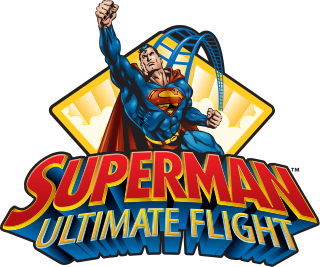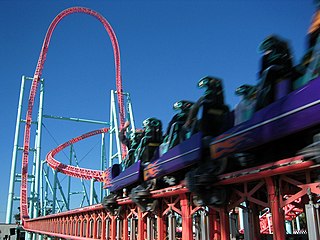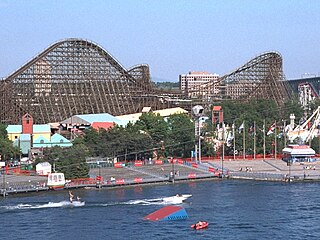
A stand-up roller coaster is a roller coaster designed to have the passengers stand through the course of the ride.

The Mindbender is an Anton Schwarzkopf looping roller coaster located at Galaxyland Amusement Park, a theme park located in West Edmonton Mall, in Alberta, Canada. The ride officially opened to the public on December 20, 1985 at a cost of $6 million. At 44.2 m (145 ft) in height, it is the tallest indoor roller coaster in the world as of 2020.

Corkscrew is a steel roller coaster built by Arrow Development at Cedar Point in Sandusky, Ohio, United States. When built in 1976, it was the first roller coaster in the world with 3 inversions. The coaster, which features Arrow's first vertical loop, was built during the same time period as The Great American Revolution at Magic Mountain. However, Revolution opened seven days prior and is therefore credited as the first modern-day coaster to feature a vertical loop.

Superman: Ultimate Flight is the name of three flying roller coasters currently operating at three Six Flags amusement parks in the United States, those being Six Flags Over Georgia, Six Flags Great Adventure and Six Flags Great America. Each of these steel coasters were designed and built by Swiss manufacturer Bolliger & Mabillard and opened in 2002 and 2003. Since 2003, Six Flags has installed Superman: Ultimate Flight in three of their parks. Themed to the popular comic book character, Superman: Ultimate Flight simulates flying by positioning its passengers parallel to the track, supported by harnesses and facing the ground through most of the ride. In the station, riders board the train sitting down. After the train is locked and checked, the trains are raised into the flying position. After the ride, the seats are lowered back into the sitting position for the next round of riders.

A Giant Inverted Boomerang is a type of steel shuttle roller coaster manufactured by the Dutch firm Vekoma. The ride is a larger, inverted version of Vekoma's popular Boomerang sit down roller coasters. As of June 2021, five installations of the model are operating, with another one under construction.

The Suspended Looping Coaster is a model of steel inverted roller coaster built by Vekoma. There are at least 39 different installations across the world. The minimum rider height requirement is 130 centimetres. Vekoma is now marketing a Suspended Thrill Coaster as a successor to the Suspended Looping Coaster. The Odyssey is the largest, fastest and tallest SLC ever built at Fantasy Island in the UK.

Xcelerator is a steel launched roller coaster at Knott's Berry Farm in Buena Park, California. It was Intamin's first hydraulically launched coaster, while also the fourth Intamin installation at Knott's, alongside The Sky Cabin, Bigfoot Rapids and Perilous Plunge.

An Accelerator Coaster is a hydraulically launched roller coaster model from Intamin. The model usually consists of a long, straight launch track, a top hat tower element, and magnetic brakes that smoothly stop the train without making contact. The technology was developed by Intamin engineers as an alternative to electromagnetic launch systems, such as the Linear Induction Motor (LIM) and Linear Synchronous Motor (LSM), that are found on earlier launched roller coasters like the Flight of Fear and The Joker's Jinx. Unlike the earlier linear induction motors, the Accelerator Coaster's launch system exhibits constant acceleration and is capable of reaching greater speeds.

Galactica is a flying roller coaster located in the Forbidden Valley area of Alton Towers amusement park in Staffordshire, England and is the first flying coaster manufactured by Bolliger & Mabillard. Guests ride in a prone position and experience the feeling of flight by "flying" close to the ground, under footpaths, and narrowly past trees and rocks.

Nighthawk is a steel flying roller coaster from Vekoma located at Carowinds amusement park. The roller coaster originally opened as Stealth at California's Great America on April 1, 2000. In 2003, Paramount decided to relocate the roller coaster to Carowinds. It reopened as Borg Assimilator – the first coaster in the world to be themed to Star Trek – on March 20, 2004. After Cedar Fair purchased Carowinds in 2006, Paramount themes were soon removed from the park, and the ride was renamed Nighthawk. It is one of only two Flying Dutchman models still in existence from Vekoma.

Phantom's Revenge is a steel roller coaster at Kennywood amusement park in West Mifflin, Pennsylvania. When it opened as Steel Phantom in 1991, it featured the fastest speed and longest drop of any roller coaster in the world. The ride was originally manufactured by Arrow Dynamics but was later modified and renovated by D.H. Morgan Manufacturing prior to the 2001 season, when it reopened as Phantom’s Revenge. The changes included an increased drop and track length, as well as the removal of its four inversions. It features a unique characteristic of having a second drop that is longer than its first.

The Tower of Terror II was a steel shuttle roller coaster located at the Dreamworld amusement park on the Gold Coast, Queensland, Australia. When the Tower of Terror opened on 23 January 1997, it was the first roller coaster in the world to reach 100 miles per hour (160 km/h), making it the tallest and fastest roller coaster in the world of its time. The ride was situated on the Dreamworld Tower, which also houses The Giant Drop free fall ride. The ride was originally known as the Tower of Terror until it was modified and relaunched in September 2010.

A Suspended Family Coaster is a steel inverted roller coaster built by Vekoma designed for families with no inversions. Just like all inverted roller coasters the train runs under the track with the seats directly attached to the wheel carriage. This latter attribute is what sets it apart from the older suspended swinging coaster, which runs under the track, but "swings" via a pivoting bar attached to the wheel carriage.

Silver Bullet is a western-themed steel inverted roller coaster designed by Bolliger & Mabillard located at Knott's Berry Farm, an amusement park in Buena Park, California. The $16 million roller coaster was announced on December 1, 2003 and opened on December 7, 2004. A first rider auction was also held where people would bid on seats to be the first riders. The track is approximately 3,125 feet (952 m) long and the lift hill is about 146 feet (45 m) tall. The ride lasts two minutes and thirty seconds and features six inversions including a vertical loop, cobra roll, zero-g roll, and two corkscrews.

Le Monstre is a wooden roller coaster at La Ronde amusement park in Montreal, Quebec, Canada. Le Monstre is the largest wooden roller coaster in Canada and is also the tallest two-track wooden roller coaster in the world.
Roller coaster elements are the individual parts of roller coaster design and operation, such as a track, hill, loop, or turn. Variations in normal track movement that add thrill or excitement to the ride are often called "thrill elements".

The Odyssey is a roller coaster at Fantasy Island in Ingoldmells, England. Built by Vekoma of the Netherlands in 2002, it was named to commemorate the Golden Jubilee of Queen Elizabeth II. It is Vekoma's tallest example of their Suspended Looping Coaster (SLC) design in the world. Standing at 167 feet, it is the third tallest roller coaster in the UK, after the Pepsi Max Big One and Stealth .And the joint second tallest full circuit inverted rollercoaster in the world. It has a maximum speed of 63 mph and is capable of forces up to 4.8g.

Blue Fire is a launched roller coaster at Europa-Park. The coaster opened in 2009 as part of a new Iceland-themed expansion to Europa-Park. As the first launched coaster built by Mack Rides, Blue Fire was the park's tenth roller coaster and the first to feature inversions. The ride's tagline is "Discover Pure Energy".

Maxx Force is a launched steel roller coaster at Six Flags Great America amusement park in Gurnee, Illinois United States. It opened on July 4, 2019, and was manufactured by S&S - Sansei Technologies. The ride holds the record for fastest accelerating launch in North America at 78 miles per hour (126 km/h) in 1.8 seconds, as well as the fastest inversion in the world at 60 miles per hour (97 km/h), and the tallest double inversion in the world at 175 feet (53 m).
The Ride to Happiness is an upcoming steel spinning roller coaster located at Plopsaland in Adinkerke, near the town of De Panne in Belgium. It is Europe's first Mack Rides Xtreme Spinning Coaster, and upon opening, the coaster will hold the record for the most inversions on a spinning coaster. The attraction is themed after the Tomorrowland Music festival.






















